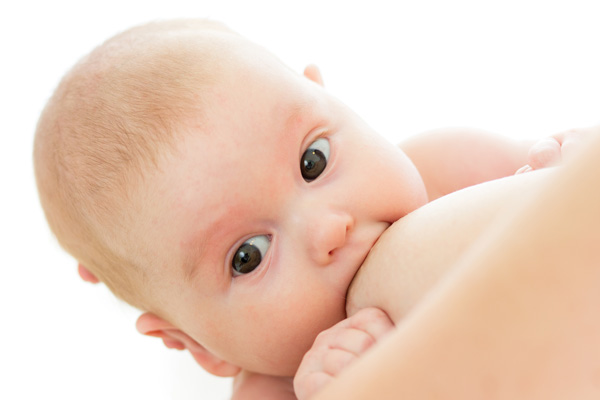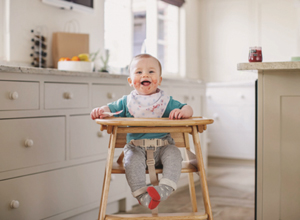by Karen Emery
Founder of Haven & Base,
Perinatal Practitioner, Parent Coach & Children’s Sleep Advisor
It wasn’t too long ago that we thought newborn babies couldn’t do much at all, other than eat, sleep and cry. But the exact opposite is true. Newborn babies are born with amazing communication capabilities and are primed and ready for social contact with their parents and caregivers right from birth. More importantly, brain science has shown us just how important this early communication is between a baby and their parent for a baby’s brain development.
Many parents are unaware that a human baby is born with an undeveloped brain and that a baby’s brain and nervous system grows most rapidly in the first few years following birth. A baby’s brain grows and develops in response to their environment but crucially in response to the interactions that a baby shares with their parent(s) and caregivers. Communication is more than talking. It’s any form of message sent from one party to another through sounds, words, or physical hints like body language. From the first moment that your baby is placed in your arms, you and your baby will be communicating with each other. These first glances, sounds, and touches literally shape the way in which your baby’s brain will grow and develop.
Everyone knows that babies cry but did you know that every baby has their own crying repertoire? Every baby has a unique and different cry for a different reason. Unlike other mammal babies, human babies are born completely dependent upon their parent or caregiver for survival and their ability to cry is very important for alerting an adult that something is wrong, or a change is needed. Babies have different cries for different reasons: a hungry baby may cry in a low or short pitched tone, while a baby who is angry or upset may cry in a choppier tone. As your baby grows, you as a parent will be able to recognise and understand what need that your baby is expressing. Even if we as parents cannot always work out why our baby is crying and what our baby is trying to express to us, it’s always important to respond to your baby’s cry for help. Responding to your baby’s cries (even when we may not know what they are crying for) helps to make your baby feel safe, secure, listened to, and heard. You cannot spoil a baby when you are meeting their physical and emotional needs.
Babies love talking! Although a baby doesn’t say a meaningful word until they are about a year old, they love to ‘take turns’ communicating with you as a parent or caregiver with facial expressions, gurgles, coo’s and body language. Why not give this a try? Find a moment when your baby is quiet but alert and give this ‘turn taking’ a go. Position your baby in front of you gazing into their eyes. What ever your baby does – you copy. If your baby gurgles, you gurgle back. Always wait for your baby to respond. This is a beautiful way to connect with your baby but don’t expect a full-blown conversation for hours at a time. Newborns can only manage this type of interaction for a few moments at each sitting before it can become over stimulating for their immature nervous system. As your baby grows and develops you can spend longer gazing at one another and conversing for longer periods each time but it’s always best to follow your baby’s lead. When your baby has had enough, they may look away, grimace, arch their back or posset (spit up milk). Crying is usually the last signal that your baby has had enough, and a change is needed.
This is the second article of three in a series about babies. In my final article, which will be available in the summer edition, I will discuss sleep tips for babies aged from birth until three months old.
You can learn more about how to communicate with your baby by visiting www.havenandbase.com
Karen Emery is available for VIRTUAL one-to-one parent-baby consultations.
You can email her for an appointment at hello@havenandbase.com






 Organix weaning and finger foods help babies discover new shapes, tastes and textures, and our wide range of toddler snacks provide parents with healthier snacking options to fuel happy days.You can find heaps of further information in the Organix Baby & Toddler Cookbook which has over 70 quick and easy recipes from weaning purees to dinner time faves for the whole family to enjoy!
Organix weaning and finger foods help babies discover new shapes, tastes and textures, and our wide range of toddler snacks provide parents with healthier snacking options to fuel happy days.You can find heaps of further information in the Organix Baby & Toddler Cookbook which has over 70 quick and easy recipes from weaning purees to dinner time faves for the whole family to enjoy!
 Perhaps the elemental nature of motherhood can’t quite be understood until we are ‘in’ our experience, or maybe we wouldn’t head on this collision course with life if we knew what was ahead? If this were the case, why do so many of us go on to do it time and again? Creating life can be addictive, because although oxytocin is understood by endocrinologists as an antidote to craving, the positive feedback mechanism that controls its release actually helps anaesthetise us a little, or diminish the sensations of discomfort, and feelings of turmoil that are intrinsically linked with pregnancy, childbirth and motherhood.
Perhaps the elemental nature of motherhood can’t quite be understood until we are ‘in’ our experience, or maybe we wouldn’t head on this collision course with life if we knew what was ahead? If this were the case, why do so many of us go on to do it time and again? Creating life can be addictive, because although oxytocin is understood by endocrinologists as an antidote to craving, the positive feedback mechanism that controls its release actually helps anaesthetise us a little, or diminish the sensations of discomfort, and feelings of turmoil that are intrinsically linked with pregnancy, childbirth and motherhood. ing a child and everything that comes with it, not just with gratitude, which helps lessen the sense of heaviness, but also with conviction, so as to empower us?
ing a child and everything that comes with it, not just with gratitude, which helps lessen the sense of heaviness, but also with conviction, so as to empower us?









